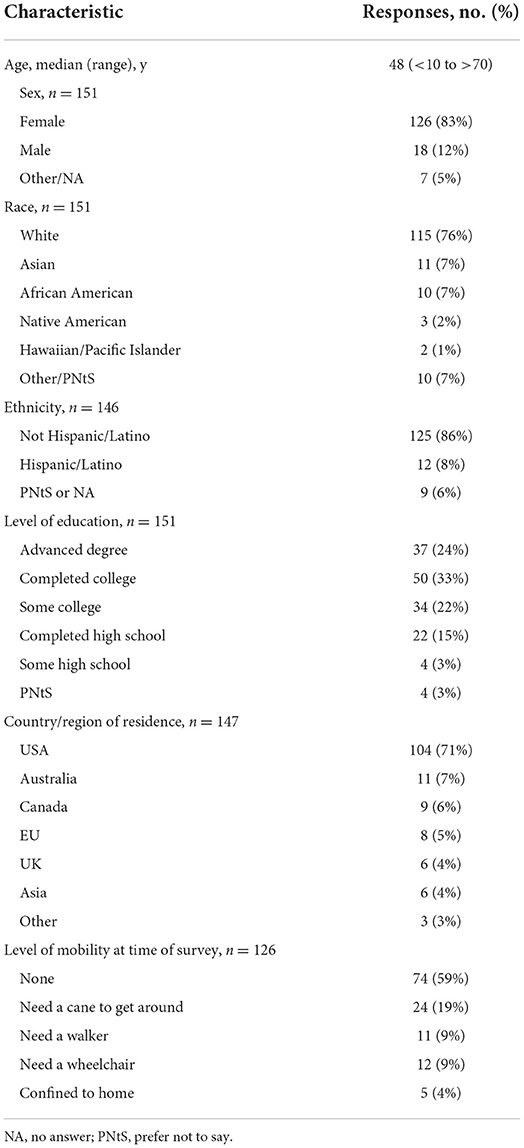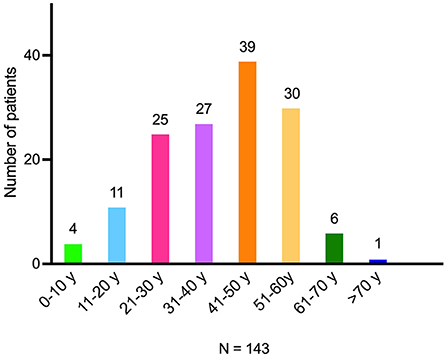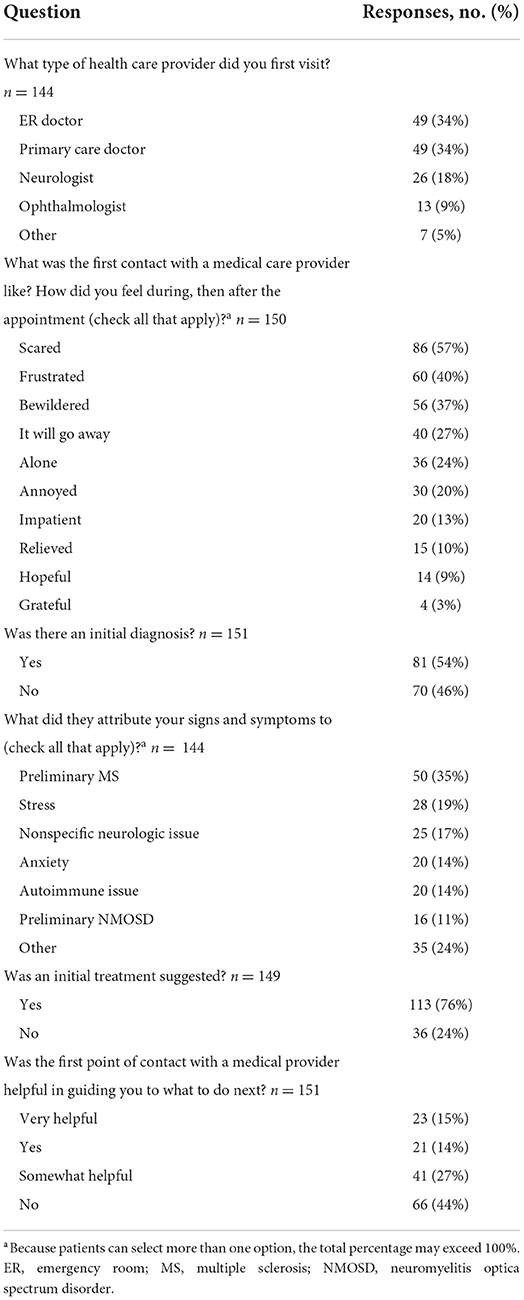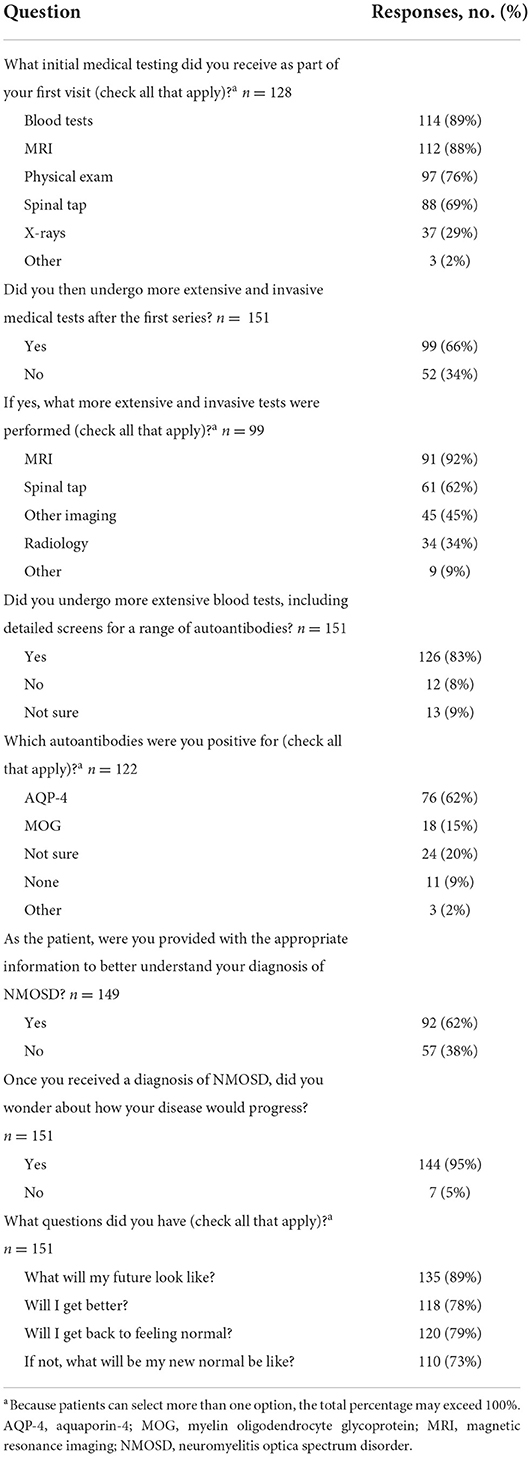- 1Department of Clinical Neurosciences, Cumming School of Medicine, University of Calgary, Calgary, AB, Canada
- 2Centro de Investigacion y Desarrollo en Ciencias de la Salud (CIDICS), Universidad Autonoma de Nuevo Leon, Monterrey, Mexico
- 3Patient Advocacy, Horizon Therapeutics, Deerfield, IL, United States
- 4Patient at Neuromyelitis Optica Clinic and Research Laboratory, Massachusetts General Hospital, Boston, MA, United States
- 5Neuromyelitis Optica Clinic and Research Laboratory, Department of Neurology, Massachusetts General Hospital/Harvard Medical School, Boston, MA, United States
Objective: To better understand the patient experience with neuromyelitis optica spectrum disorder (NMOSD) through the course of the illness.
Background: NMOSD is a rare autoimmune disorder that causes recurrent inflammatory attacks of the optic nerve, spinal cord, and brain. Knowledge and awareness of NMOSD in the general medical community are often limited, resulting in potential delays in diagnosis and treatment.
Design/methods: We developed a comprehensive 101-question survey to understand the patient's perspective on their journey from initial presentation to present condition. The survey covered basic demographics, symptoms, medical tests used to reach a diagnosis, and the patient's psychosocial responses to their diagnosis. The survey included questions to determine internal consistency in responses. We shared the survey with members of the Neuromyelitis Optica (NMO) Clinic Facebook group and received responses from 151 patients. All data collected were self-reported and presented as summary statistics.
Results: The majority of survey responses were from patients who were female (83%) and White (76%), Asian (7%), or African American (7%). Initial symptoms of disease included fatigue, pain, stiffness/spasticity, bladder and bowel dysfunction, cognitive/emotional symptoms, and visual disturbances. Initial reactions to NMOSD diagnosis were frequently fear, anxiety, and/or depression. Mean (SD) time to diagnosis was 2.2 (3.2) years. First contact with a medical professional was felt to be not helpful or somewhat helpful for many patients (71%), in part due to uncertain diagnosis and/or treatment. However, once referred to specialists (primarily neurologists), the majority of patients (87%) reported finding a professional who could help. Tests leading to diagnosis included magnetic resonance imaging, lumbar puncture, and blood tests for autoantibodies including aquaporin-4 (AQP4) and myelin oligodendrocyte glycoprotein (MOG). While approximately 30% of patients still felt challenged for a variety of reasons, most patients reported that having a diagnosis and being under the care of a specialist contributed to a comprehensive plan with hope for their future.
Conclusions: The NMOSD patient journey frequently begins with anxiety, fear, and frustration. Finding the right specialist and identifying appropriate screening tests can lead to earlier diagnosis and progression toward better patient outcomes.
Introduction
Neuromyelitis optica spectrum disorder (NMOSD) is a rare and severe autoimmune disease characterized by inflammation of the optic nerve and spinal cord (1–3). This chronic and potentially debilitating condition is typically marked by multiple relapses that can result in progressive neurologic disabilities, blindness, and even death (1, 3–5). NMOSD has prevalence ranging from 0.5 to 10 per 100,000 in most populations, with considerable global and regional variation (5–8). African Americans are overrepresented in the US patient population (9). A recent survey of patients with NMOSD in North America reported a population who was White (53%), African American (24%), Hispanic (12%), and Asian (9%) (6).
NMOSD was initially considered to be a clinical subtype of multiple sclerosis (MS) as both disorders present with similar symptoms including optic neuritis, myelitis, and demyelination (1, 9–11). NMOSD generally manifests as a series of discrete attacks (1, 9). Relapses occur in 80%-90% of patients, frequently within 1 to 3 years after the initial episode (1, 9). Recovery after an attack often is partial, and the level of disability increases with each relapse, leading to impaired mobility or blindness (1, 9).
Initial symptoms of NMOSD include mild to severe paralysis and ocular pain with loss of vision (1, 9). Other symptoms include intractable hiccups, nausea and vomiting, hearing loss, cranial nerve dysfunctions, sleep abnormalities, narcolepsy, bladder and bowel dysfunction, and acute respiratory failure (1, 4, 12, 13). NMOSD and MS are difficult to distinguish in the early course of disease. The identification of autoantibodies to aquaporin-4 (AQP4-IgG) as highly specific markers of NMOSD has facilitated differential diagnosis (10). Approximately 80% of patients with NMOSD express detectable levels of AQP4-IgG; however, antibody titers by themselves do not seem to be predictive of disease course or outcome (14–16).
The diagnostic odyssey for a patient with NMOSD can be complicated because there is significant variability in clinical presentation and disease course over time (17). NMOSD is frequently misdiagnosed, especially in patients with clinical signs who are seronegative for established biomarkers such as AQP4-IgG and myelin oligodendrocyte glycoprotein autoantibodies (MOG-IgG) (3, 10, 17). Primary care providers and emergency departments, who are often the first points of health care contact, generally have limited or no experience diagnosing and/or treating patients with NMOSD (17–19).
To better understand the challenges and experiences of patients with NMOSD, we explored how patients navigate the early stages of their disease using a survey. The aims of this survey were to identify what patients perceive to be their challenges to diagnosis and treatment and to help health care providers better understand this journey from the patients' point of view.
Methods
We worked with rareLife Solutions, Inc. to develop a detailed survey to explore the patient's perspective on their initial diagnostic journey from early symptoms to diagnosis and treatment of NMOSD. The survey was shared with members of the Neuroimmunology Clinic (formerly NMO Clinic, Boston, MA, USA) private Facebook group. A pilot survey was administered to a group of 23 volunteers who self-identified as patients. Responses were assessed for completeness, consistency with known baseline values, and demographics for the NMOSD population. The responses obtained from the pilot survey were used to develop a final survey, which was made available in an online format to the full group of patients in the Neuroimmunology Clinic private Facebook group. Survey questions focused on patient population (baseline demographics), signs and symptoms of patients' first clinical events, their initial experiences with the health care system, the diagnostic process, and treatment options. We also focused on the psychological reactions that patients with NMOSD experienced as they were diagnosed with this rare disease. Questions were primarily multiple choice with additional opportunities for patient narratives through inclusion of 6 free-form questions. Survey responses were fielded through SurveyMonkey in a de-identified case report form, and results were collected in September 2020. All data collected were self-reported by the respondents, and the survey could only be completed one time. To participate in the survey, respondents had to agree and grant permission via an active response for their data to be used in an aggregated and anonymized manner. Data were anonymized in accordance with General Data Protection Regulation and presented as summary statistics. When narrative responses were reported, any details that could be used to identify respondents were removed.
Results
Respondents were required to agree to the following statement before they could proceed with the survey: “Please be aware that we will be gathering and processing your responses in total and that while no individual information will be shared with anyone, your responses will be combined and analyzed with all other respondents. Most importantly, your responses will be held in strict confidence. If you are comfortable with that, please continue with the survey, by clicking the button below.”
Patient responses obtained during the pilot survey indicated that patients understood the questions and were actively engaged with the project, as demonstrated by the following: (1) a large percentage of patients answered most, if not all, the questions; (2) patient responses were complete and consistent with known facts about NMOSD; and (3) answers were internally consistent with information provided in response to other related questions in the survey.
Of the 160 volunteers who participated in the final survey, 151 identified themselves as patients, and 9 were advocates and caregivers. Only data from self-identified patients are reported in this article. These data were presented in part as a poster for the 2021 annual meeting of the American Academy of Neurology (20).
Patient demographics and baseline physical condition
Respondents to this survey were predominantly female (83%), White (76%), and from the United States (71%) (Table 1), which is representative of the group in general. More than half had completed college or advanced degrees. Median age was 48 (<10 to >70) years (Figure 1) and mean age at disease onset was 40.3 years. Time from diagnosis to this survey was within 4 years for 66/123 (54%) respondents; an additional 40/123 (33%) were diagnosed between 5 and 9 years before this survey, and 15/123 (12%) were diagnosed between 10 and 19 years before this survey. Fifty-two patients reported problems with mobility (requiring a cane, walker, or wheelchair, or being homebound).
Characteristics of first NMOSD attack
In all, 73% (110/151) of patients described their first attack as serious or worse, with 5% (7/151) reporting it as life-threatening (Figure 2). Eightythree percent (125/151) of respondents experienced pain, 81% (123/151) experienced fatigue, and 63% (95/151) experienced stiffness or spasticity (Figure 3A). Of the patients who reported an impact on their vision, 94% (88/94) experienced visual disturbances, 39% (37/95) experienced double vision, 71% (67/94) experienced loss of peripheral vision, and 61% (58/95) experienced loss of central vision (Figure 3B). Patients also reported other physical symptoms including bladder problems 47% (71/151), bowel problems 39% (58/150), and sexual dysfunction 36% (54/148) (Figure 3C). Additionally, cognitive and emotional symptoms were reported by 59% (89/150) of patients and included brain fog, mood swings, and anxiety (Figure 3D).
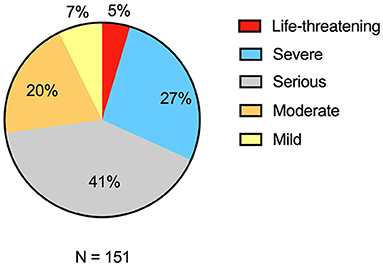
Figure 2. Severity of the first attack of NMOSD. Patients reported severity of first events to range from mild to life-threatening. NMOSD indicates neuromyelitis optica spectrum disorder.
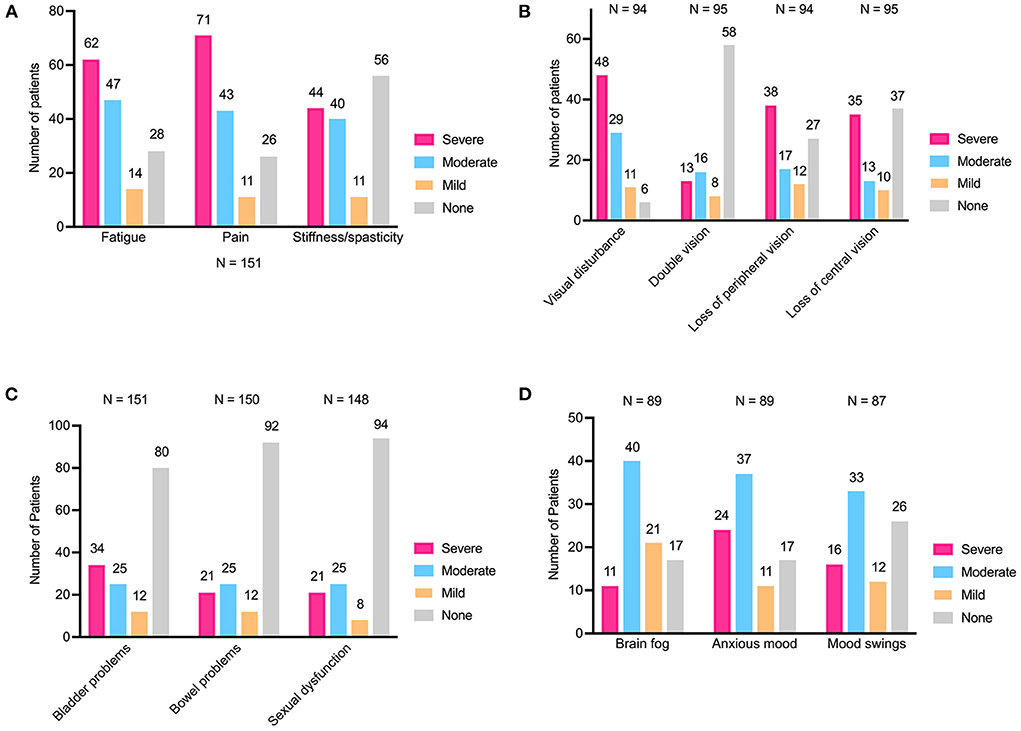
Figure 3. Signs and symptoms encountered during an initial attack of NMOSD. (A) Fatigue, pain, and stiffness/spasticity. (B) Visual disturbances, double vision, loss of peripheral vision, and loss of central vision. (C) Bladder and bowel problems, sexual dysfunction. (D) Brain fog, anxious mood, and mood swings. NMOSD indicates neuromyelitis optica spectrum disorder.
This survey contained questions that afforded patients the opportunity to write narrative comments about various aspects of their diagnostic journey. Initial attacks of NMOSD were often described as painful and frightening (Supplementary Table 1). One patient described their initial experience as follows: “Two weeks of severe cold that developed into flu symptoms with headache, weakness, and body aches. I was placed on an antibiotic. The headache worsened and I developed blurred vision and loss of vision in one eye. My antibiotic was changed. Two days later, I developed severe abdominal pain. While in the ER, the weakness progressed to paralysis from the chest down.”
First experience with health care system
Patients often described their the initial contact with the health care system using terms such as “scared,” frustrated,” and “bewildered” (Table 2). It was noted that 107 of 151 (71%) patients responded that their first contact with a medical professional was “not helpful” or only “somewhat helpful” in guiding them toward their next steps. Fewer than 10% of patients described their initial contact with a medical provider as “hopeful.” Only 16 of 144 (11%) were diagnosed as having preliminary NMOSD. Initial treatments were prescribed for ~75% of patients and included prednisone/methylprednisolone, gabapentin, baclofen, azathioprine, or rituximab. Other initial treatments offered included antibiotics, pain medications, exercise, and a referral to a psychiatrist. Almost all (148/151) patients provided brief narrative acounts of their initial experiences, coping strategies, and emotional responses to the sudden challenges of their attack (Supplementary Table 2). One patient described their experience as follows: “Initially, I felt scared and bewildered. No one understood what was going on. There was nothing to help me see better to start school, no treatment suggested to correct my vision[,] and no reason why it was happening. They were just unanswered questions. When the doctors couldn't figure out what was wrong and was happening, they accused me of faking and suggested a psychiatrist to my parents.”
Path toward a diagnosis and treatment
Time from the first onset of symptoms to a diagnosis of NMOSD ranged from 1 month (20%) to more than 10 years (9%) (Table 3). The mean (SD) time to diagnosis was 2.2 (3.2) years and the median time was 7 months. Many patients subsequently proceeded to seek additional help, and care often transitioned from a general practitioner to a specialist, who was a neurologist for 98% of patients. Over half of patients reported feeling relieved after meeting their NMOSD specialist. Approximately half of patients had to go to a major academic medical center to see their specialist. Travel and time away from home were frequently required for patients to see their specialist, but travel was rarely international. Clinical and laboratory tests used to confirm NMOSD included physical examination, blood tests, magnetic resonance imaging, and lumbar puncture (Table 4). After the first series of tests, 99 of 151 (66%) of patients had to undergo further extensive tests which often included additional imaging and radiology. Seventy-six (69%) of the 110 patients who reported being tested for AQP4-IgG; had a positive response, and 18 (32%) of the 56 patients who reported being tested for MOG-IgG had antibodies. Approximately two-thirds of patients reported that they were provided with the appropriate information to help them understand their diagnosis of NMOSD. Patients reported that they were taking a mean of 1.8 medications for NMOSD, and almost two-thirds of them were taking rituximab (Figure 4). Approximately half of the respondents had received at least one plasmapheresis treatment.
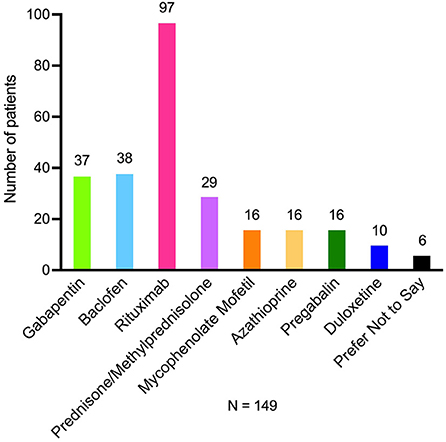
Figure 4. Current medications being used for treatment of NMOSD symptoms. One hundred forty-nine patients reported taking 1.8 medications each (mean) for NMOSD symptoms. NMOSD indicates neuromyelitis optica spectrum disorder.
After meeting with an NMOSD specialist, 132 of 151 (87%) patients reported that they felt they had access to a professional who could guide them with treatment decisions (Table 5). In all, 106 of 150 (71%) respondents stated that they understood and could take advantage of their best treatment options, and 105 of 150 (70%) had a comprehensive care and recovery plan in place. After receiving their diagnosis and beginning to work with an NMOSD specialist, the majority of patients reported feeling relieved; however, others felt unhappy or lost. Upon diagnosis, patients had to confront their new reality of having NMOSD (Supplementary Table 3). “It was hard being diagnosed. I was a month and a half away from getting married. I had always been healthy up until I wasn't. I had no real medical history. I was so scared of what the future would hold. Would I be blind? Would I be in a wheelchair? Would I be able to have children? Would I be dead in 5 years?”
After a period of mourning their old lives and accepting the permanent losses, patients frequently began adjusting to a “new normal.” When asked whether patients felt confident that they can now “live your best life,” the responses were more positive than negative, although many patients still struggle with a life of limitations (Supplementary Table 4). “I'm adjusting to my new normal. But I feel like every time something new goes numb, or something doesn't feel right, I have to wonder if it's an [NMOSD] attack. So, dealing with the unknown is a fear I live with every day.”
Discussion
Our survey provides information that describes the symptoms of the initial attack of NMOSD and patients' reactions to this experience while navigating the health care system to the point where a correct diagnosis was obtained. This survey is the first, to the best of our knowledge, that focuses on the patient's initial NMOSD attack and provides a substantial opportunity for patients to provide narrative responses regarding their feelings and reactions to their experience. Our patient population had essentially the same characteristics as those in other surveys of patients with NMOSD, suggesting that they are representative of the NMOSD populations who participate in surveys (17, 21–24). Unlike in previous surveys that used standardized assessment instruments, we intentionally designed ours to allow patients to express their feelings in a free form. Despite the subjective nature of our survey, our results were very similar to those from surveys that utilized standardized tools with the additional important benefit that we were able to obtain very personal insights into patients' feelings and psychological state as they navigated their path through diagnosis and treatment (17, 21–24). In future surveys, it would be of interest to go even deeper into patient experiences to explore issues such as how regional differences affect their journey and how NMOSD has affected their ability to work and interact in society.
We believe that the NMO Clinic private Facebook community was highly motivated to share their journeys, as indicated by the number of patients completing the long and detailed survey. A large percentage of patients provided thoughtful narrative answers where appropriate. We believe adding questions that could elicit narrative responses enabled the patients to delve more deeply into questions about their quality of life and emotional experiences. For example, 148 out of 151 patients (98%) responded to questions about their coping strategies and emotional reactions to their diagnostic experience.
Patients' descriptions of their first attack of NMOSD and their contact with medical professionals clearly demonstrate how distressing the process can be. Patients describe fear, frustration, and disappointment. Patients describe how they were often confronted with sudden, distressing, and painful attacks of NMOSD with relatively little support or understanding from the medical community, especially emergency departments, primary care physicians, and neurologists, due to lack of knowledge of NMOSD (19). Increased understanding of NMOSD by physicians can help preserve vision and avoid permanent disability as well as help patients transition more efficiently to the right specialists (19). Finding the right specialist and identifying appropriate screening tests can lead to an earlier correct diagnosis and faster progress toward better treatment and outcomes (10, 19).
Understanding the patient journey can yield important insights that could have a beneficial impact on patient care. This Facebook group and other social media networks like PatientsLikeMe provide access to many patients who have NMOSD and should be utilized to expand awareness to a broader patient and physician population (23). Patient responses to this survey provided detailed insights into the challenges that they encountered as they tried to find the best path forward in their new life. Utilizing patient narratives in publications can help clinicians empathize with the experiences that are often so frightening and disturbing to their patients (25–27). We believe that adding narrative questions within this survey may have allowed respondents to more freely express their feelings, helped them believe that they were being heard, and helped them to be more engaged in this survey.
The goal of this survey was to gather information on current patient experiences to help improve the patient journey in the future. Based on the responses of several patients, it appears that more education for the medical community could help raise awareness of NMOSD and could help physicians correctly diagnose the disease as early as possible. Many patients spend a long time with a misdiagnosis, which not only aggravates their medical condition but also subjects them to great emotional and financial hardship. An early and correct diagnosis with immediate treatment would be of great value in controlling the damage caused by NMOSD.
Limitations
As this survey was designed to elicit self-reported responses, individual experiences can be very subjective and less likely to provide quantitative data about specifics of NMOSD. Respondents may have very different perceptions of what “mild” or “serious” means with respect to disease or symptom severity. Moreover, they were often asked subjective questions about their feelings and perceptions. There are also challenges validating a patient's identity and diagnosis through a social media platform. There was no restriction on members of the group sharing the survey link externally, and no validation process was used to confirm that the respondents were in fact patients with NMOSD.
Data collected in this survey came primarily from patients in the United States (71%). Results cannot necessarily be generalized and may differ between regions and health care systems. A potential limitation of this study is that respondents were those who volunteered to complete this online survey. Therefore, individuals without access to the internet or who were unable to see or have the strength to participate were unlikely to complete the survey unless they had a friend or family member complete it with them. Although we queried the status of each respondent (patient, caregiver, or advocate), we did not expressly ask whether respondents were being aided by another person. No person was purposely excluded from the survey, and we did not specifically ask whether respondents were capable of completing the survey unaided.
Conclusions
Patients with NMOSD face a diagnostic journey that frequently begins with fear, confusion, and frustration. Initial contact with the medical community in the form of emergency departments or primary care physicians can often lead to misdiagnosis due to lack of knowledge about this rare disease. The survey indicates that when given the opportunity, patients are willing to share their experiences in their own words. As patients connect with specialists who provide the correct diagnosis of NMOSD and a treatment plan is developed, patients frequently experience hope for an improved “new normal.”
Data availability statement
The raw data supporting the conclusions of this article will be made available on reasonable request.
Ethics statement
Ethical review and approval was not required for the study on human participants in accordance with the local legislation and institutional requirements. The patients/participants provided their written informed consent to participate in this study.
Author contributions
GD-G and ML were involved in the development of the survey. All authors were involved in the interpretation of the results.
Funding
Medical writing services were supported by Horizon Therapeutics.
Acknowledgments
The authors thank the participants of this survey for giving their time and volunteering their information. The authors would also like to thank rareLife solutions for developing the survey under their guidance and analyzing the results and Eliza A. Donovan, PharmD candidate, University of Southern California, for collating the responses and assisting with the analysis. Medical writing support was provided by Michele Kinrade, Ph.D., of rareLife solutions, Westport, CT, USA, and supported by Horizon Therapeutics.
Conflict of interest
GD-G has received research support from the Consejo Nacional de Ciencia y Tecnologia, Mexico. ML received consulting fees from Alexion (now Alexion, AstraZeneca Rare Disease), Genentech/Roche/Chugai, Sanofi, UCB Pharmaceuticals, and Viela Bio (since acquired by Horizon Therapeutics). SL is an employee of Horizon Therapeutics and holds stock in the company. RT is a patient participating in a clinical trial of ravulizumab sponsored by Alexion, AstraZeneca Rare Disease.
The authors declare that this study received funding from Horizon Therapeutics for the preparation and submission of the manuscript. The funder was involved in the review of this article and the decision to submit it for publication.
Publisher's note
All claims expressed in this article are solely those of the authors and do not necessarily represent those of their affiliated organizations, or those of the publisher, the editors and the reviewers. Any product that may be evaluated in this article, or claim that may be made by its manufacturer, is not guaranteed or endorsed by the publisher.
Supplementary material
The Supplementary Material for this article can be found online at: https://www.frontiersin.org/articles/10.3389/fneur.2022.966428/full#supplementary-material
References
1. Wingerchuk DM, Lennon VA, Lucchinetti CF, Pittock SJ, Weinshenker BG. The spectrum of neuromyelitis optica. Lancet Neurol. (2007) 6:805–15. doi: 10.1016/S1474-4422(07)70216-8
2. Wingerchuk DM, Fujihara K, Palace J, Berthele A, Levy M, Kim HJ, et al. Long-term safety and efficacy of eculizumab in aquaporin-4 IgG-positive NMOSD. Ann Neurol. (2021) 89:1088–98. doi: 10.1002/ana.26049
3. Wingerchuk DM, Banwell B, Bennett JL, Cabre P, Carroll W, Chitnis T, et al. International consensus diagnostic criteria for neuromyelitis optica spectrum disorders. Neurology. (2015) 85:177–89. doi: 10.1212/WNL.0000000000001729
4. Borisow N, Mori M, Kuwabara S, Scheel M, Paul F. Diagnosis and treatment of NMO spectrum disorder and MOG-encephalomyelitis. Front Neurol. (2018) 9:888. doi: 10.3389/fneur.2018.00888
5. Tenembaum S, Yeh EA, Guthy-Jackson Foundation International Clinical Consortium. Pediatric NMOSD: a review and position statement on approach to work-up and diagnosis. Front Pediatr. (2020) 8:339. doi: 10.3389/fped.2020.00339
6. Cook LJ, Rose JW, Alvey JS, Jolley AM, Kuhn R, Marron B, et al. Collaborative international research in clinical and longitudinal experience study in NMOSD. Neurol Neuroimmunol Neuroinflamm. (2019) 6:e583. doi: 10.1212/NXI.0000000000000583
7. Pandit L, Asgari N, Apiwattanakul M, Palace J, Paul F, Leite MI, et al. Demographic and clinical features of neuromyelitis optica: a review. Mult Scler. (2015) 21:845–53. doi: 10.1177/1352458515572406
8. Bukhari W, Khalilidehkordi E, Mason DF, Barnett MH, Taylor BV, Fabis-Pedrini M, et al. NMOSD and MS prevalence in the indigenous populations of Australia and New Zealand. J Neurol. (2022) 269:836–45. doi: 10.1007/s00415-021-10665-9
9. Oh J, Levy M. Neuromyelitis optica: an antibody-mediated disorder of the central nervous system. Neurol Res Int. (2012) 2012:460825. doi: 10.1155/2012/460825
10. Jarius S, Wildemann B. Aquaporin-4 antibodies (NMO-IgG) as a serological marker of neuromyelitis optica: a critical review of the literature. Brain Pathol. (2013) 23:661–83. doi: 10.1111/bpa.12084
11. Dobson R, Giovannoni G. Multiple sclerosis—a review. Eur J Neurol. (2019) 26:27–40. doi: 10.1111/ene.13819
12. Misu T, Fujihara K, Nakashima I, Sato S, Itoyama Y. Intractable hiccup and nausea with periaqueductal lesions in neuromyelitis optica. Neurology. (2005) 65:1479–82. doi: 10.1212/01.wnl.0000183151.19351.82
13. Rosenthal JF, Hoffman BM, Tyor WR. CNS inflammatory demyelinating disorders: MS, NMOSD and MOG antibody associated disease. J Investig Med. (2020) 68:321–30. doi: 10.1136/jim-2019-001126
14. Tradtrantip L, Yeaman MR, Verkman AS. Cytoprotective IgG antibodies in sera from a subset of patients with AQP4-IgG seropositive neuromyelitis optica spectrum disorder. Sci Rep. (2021) 11:21962. doi: 10.1038/s41598-021-01294-3
15. Kessler RA, Mealy MA, Jimenez-Arango JA, Quan C, Paul F, Lopez R, et al. Anti-aquaporin-4 titer is not predictive of disease course in neuromyelitis optica spectrum disorder: a multicenter cohort study. Mult Scler Relat Disord. (2017) 17:198–201. doi: 10.1016/j.msard.2017.08.005
16. Dauby S, Dive D, Lutteri L, Andris C, Hansen I, Maquet P, et al. Comparative Study of AQP4-NMOSD, MOGAD and Seronegative NMOSD: a single-center belgian cohort. Acta Neurol Belg. (2021) doi: 10.1007/s13760-021-01712-3
17. Beekman J, Keisler A, Pedraza O, Haramura M, Gianella-Borradori A, Katz E, et al. Neuromyelitis optica spectrum disorder: patient experience and quality of life. Neurol Neuroimmunol Neuroinflamm. (2019) 6:e580. doi: 10.1212/NXI.0000000000000580
18. Starfield B, Shi L, Macinko J. Contribution of primary care to health systems and health. Milbank Q. (2005) 83:457–502. doi: 10.1111/j.1468-0009.2005.00409.x
19. Thomas K, Ocran C, Monterastelli A, Sadun AA, Cockerham KP. Bridging the gap between ophthalmology and emergency medicine in community-based emergency departments (EDs): a neuro-ophthalmology guide for ED practitioners. Clin Pract. (2021) 11:919–32. doi: 10.3390/clinpract11040106
20. Delgado-Garcia G, Lapidus S, Stefani-Hunyady D, Levy M. “Patient attitudes toward NMOSD diagnosis and treatment: final survey results (4233),” in Poster session presented at: 73rd American Academy of Neurology Annual Meeting (2021).
21. Ayzenberg I, Richter D, Henke E, Asseyer S, Paul F, Trebst C, et al. Pain, depression, and quality of life in neuromyelitis optica spectrum disorder: a cross-sectional study of 166 AQP4 antibody-seropositive patients. Neurol Neuroimmunol Neuroinflamm. (2021) 8(3). doi: 10.1212/NXI.0000000000000985
22. Mealy MA, Boscoe A, Caro J, Levy M. Assessment of patients with neuromyelitis optica spectrum disorder using the EQ-5D. Int J MS Care. (2019) 21:129–34. doi: 10.7224/1537-2073.2017-076
23. Eaneff S, Wang V, Hanger M, Levy M, Mealy MA, Brandt AU, et al. Patient perspectives on neuromyelitis optica spectrum disorders: data from the PatientsLikeMe online community. Mult Scler Relat Disord. (2017) 17:116–22. doi: 10.1016/j.msard.2017.07.014
24. Seok JM, Choi M, Cho EB, Lee HL, Kim BJ, Lee KH, et al. Fatigue in patients with neuromyelitis optica spectrum disorder and its impact on quality of life. PLoS One. (2017) 12:e0177230. doi: 10.1371/journal.pone.0177230
25. Charon R. The patient-physician relationship. narrative medicine: a model for empathy, reflection, profession, and trust. JAMA. (2001) 286:1897–902. doi: 10.1001/jama.286.15.1897
26. Fioretti C, Mazzocco K, Riva S, Oliveri S, Masiero M, Pravettoni G. Research studies on patients' illness experience using the narrative medicine approach: a systematic review. BMJ Open. (2016) 6:e011220. doi: 10.1136/bmjopen-2016-011220
Keywords: NMOSD, neuromyelitis optica spectrum disorder, patient journey, diagnosis, patient experience, patient perspectives
Citation: Delgado-Garcia G, Lapidus S, Talero R and Levy M (2022) The patient journey with NMOSD: From initial diagnosis to chronic condition. Front. Neurol. 13:966428. doi: 10.3389/fneur.2022.966428
Received: 10 June 2022; Accepted: 02 August 2022;
Published: 06 September 2022.
Edited by:
Barbara M. P. Willekens, Antwerp University Hospital, BelgiumReviewed by:
Catherine Vignal Clermont, Fondation Ophtalmologique Adolphe de Rothschild, FranceJinming Han, Capital Medical University, China
Copyright © 2022 Delgado-Garcia, Lapidus, Talero and Levy. This is an open-access article distributed under the terms of the Creative Commons Attribution License (CC BY). The use, distribution or reproduction in other forums is permitted, provided the original author(s) and the copyright owner(s) are credited and that the original publication in this journal is cited, in accordance with accepted academic practice. No use, distribution or reproduction is permitted which does not comply with these terms.
*Correspondence: Michael Levy, bWxldnkxMUBtZ2guaGFydmFyZC5lZHU=
 Guillermo Delgado-Garcia
Guillermo Delgado-Garcia Sheryl Lapidus3
Sheryl Lapidus3 Michael Levy
Michael Levy